The Fir Tree Inn – 1753 to 1849
The story of this public house is quite complex. I have split the work into four sections; this is the start of the story, covering the first century of what we know about it.
An earlier public house than that known by the name the “Fir Tree Inn” today had previously used the same name and stood a few hundred yards further south on the other side of the Woburn road. That inn had also had two previous names, so when the story of the Fir Tree starts, it had a different name and was in a different place!
Whereas both the old and new inns stand in the modern parish of Aspley Heath in Bedfordshire, this had not been created at that time, as it was formed later from part of Aspley Guise. Most people incorrectly consider the new Fir Tree to stand in Woburn Sands, but this too is a fairly modern invention (1867) formed from parts of Aspley Guise and Wavendon. The boundaries of parish and county have fluctuated over the centuries so that the inn has also appeared in records pertaining to Wavendon in Buckinghamshire too, which used to be known as Wandon. Woburn has had many different spellings over the centuries too. One thing that hasn’t changed is that the inns were sited on a main road that had lots of passing trade – ideal for providing refreshments to travellers.
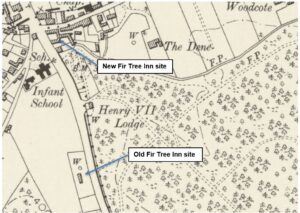
In 1704, the inhabitants of Wavendon were charged at Bucks. Quarter Sessions for not repairing their part of the road between Newport Pagnell and Woburn. Just two years later, a Toll Road was opened from Hockliffe to Woburn in 1706, the first such Toll Road in Bedfordshire. This allowed the appointed Trustees to charge a fee for nearly all traffic and travellers who used it and to use the money so raised to lay a better surface with local materials and then keep it in good repair. In the times before properly organised local authorities, this was the best way to get country roads into an acceptable condition, as they were often no more than well-worn tracks in mud and professional upkeep meant passenger coaches and goods could travel with less fear of breakdown and less strain on the horses.
In 1727 a extension to the toll road was set up, continuing the road northwards through Wavendon to Newport Pagnell. This was then renewed in 1742. It was part of the London to Manchester route, which branched away from Watling Street, the London to Chester road, at Hockliffe. After Newport Pagnell, it ran through Northampton, Leicester, Derby and Buxton. There were six Acts in force along this route before 1720 and by 1750, only 14 miles of it remained un-tolled. The road between Woburn and Newport was full of twists and turns and summits and dips that made progress of old coaches on rough roads very slow.
Whilst there were many large public houses in Woburn and Newport, there were also smaller establishments along the road in Wavendon, Aspley and Broughton to serve the passengers in coaches and farmers in wagons as well as those walking, alongside their local agricultural communities.
At that time, the extensive woods had not been planted and the area was a heathland. Woburn Sands as a separate settlement had not appeared and the scattered few houses that had grown up around the crossroads with the road from Bedford were referred to as Hogstye End, one of the ‘Ends’ of Wavendon. There were also a few cottages where the turn is for Woburn Golf Club off Woburn Road, known as Longslade.
Travelling was a dangerous affair. Toll road Trusts spent a bare minimum on maintaining their road, if at all. Being within sight of an inn afforded those travelling with some degree of protection from marauding highwaymen. Without being able to summon help quickly, it only took one man with a gun to stop a coach and help themselves to whatever they wished. The road between Woburn and Woburn Sands was remodelled extensively in the 1990’s, having previously been in a deep cutting. The cutting itself was man-made, created in 1824 so carriages did not have to go up and over a high ridge of sandy soil that was dusty in summer and a quagmire in winter. Such difficulties for horse-drawn traffic slowed them down and made them easier targets for such highwaymen. It appears “Stand and Deliver!” was a common cry in these parts, as evidenced by the following newspaper stories:
Derby Mercury – 16th October 1729
“On Wednesday Morning, between four and five o’Clock, the Nottingham Coach was robbed by a single Highwayman near Woburn in Bedfordshire, on his journey to London, wherein were six passengers, from whom he took about £4, the money was collected in a Handkerchief, which in turning into a Hat, good part of it dropt to the ground; whereupon the Highwayman commanded the Coachman to drive on, that he might have an opportunity to take it up at his leisure.”
Kentish Weekly Post or Canterbury Journal – 17th November 1739
“As his Grace the Duke of Leeds was coming to town from Yorkshire, two Highwaymen lay in ambush to rob the Coach; but being pursu’d over the country, they were taken in an ale house near Woburne in Bedfordshire; six pistols were found upon them, and they were committed to Bedford Gaol. These fellows robb’d most of the Coaches that came that way all last week.”
In 1744, a butcher from Cranfield named George Hall was attacked on his way home from working at Woburn market. £7 was stolen from him and he was cut so badly that he died. William Turvey of Aspley Guise was suspected of the crime, but was later found ‘Not Guilty’. (Full story available elsewhere on this website.)
Kentish Weekly Post or Canterbury Journal – 7th November 1750
“We hear that on Tuesday last, between the hours of five and six in the afternoon, the Nottingham Stage-Coach was robbed on Wooburn Sands, at about a mile distance from Wooburn, by a single Highwayman, who rode up to the Coachman, and required him to stand still, and them came to the side of the coach, and presented a pistol to the passengers; he was mounted on a light grey horse, wore a light coloured Horseman’s coat, his coat under it of a light colour also, but somewhat darker; he seemed to be about the age of 21 or 22 years.”
Derby Mercury – 1st June 1759
“On Tuesday Morning a Grazier near Leicester was robbed on Woobourn Sands of £104 by a Foot-pad, who got into Aspley Wood, and made off, not-withstanding a great Number of People who went in Search of him.”
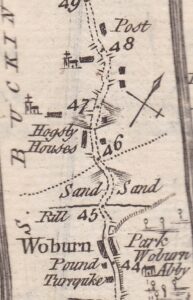
Oxford Journal – 18th February 1775
“On Thursday last as Mr Grose, of Goswell Street, was going to Woburn, he was robbed by a single highwayman, of three guineas and a half. On his return on Saturday, he was attacked on Finchley common by the same highwayman, who demanded his watch and money; but Mr Grose mentioning the circumstances of the robbery on Thursday, the highwayman declined taking anything from him, and said he was satisfied with his former booty.”
Lloyd’s Evening Post – 7th April 1775
“Friday, as Edmund Dicks, Esq; of Close End in Bedfordshire, was coming over Woburn Sands, he was robbed of twenty-three guineas by a highwayman, who observed that he had a watch, but refused it.”
St. James’s Chronicle or the British Evening Post – 22nd September 1778
“About two o’clock last Friday morning the Derby Coach was robbed on Woburn Sands, by a single highwayman, who behaved in a very polite manner; he collected from all the insides, and took 4s. 6d. from an outside passenger, but returned him half a Crown, and giving the coachman a shilling, rode off.”
Northampton Mercury – 18th December 1780
“Between Two and Three o‘Clock on Friday afternoon, the Hon. W. Cockayne, son of Lord Cullen, was robbed on Woburn Sands by a single highwayman, of ten guineas and his gold watch.”
Northampton Mercury – 25th December 1780
“Last Tuesday was committed our County Gaol, by the Rev. John Hill, Doctor at Laws, John Jones, charged by the Hon. William Cockaine, of feloniously assaulting him on the 15th inst. on Woburn Sands, and taking from him six guineas, a Gold enamelled Watch, value twelve Guineas, and a Cornelian Seal, set in gold, value £2 which were all found in his custody. A silver Watch, by Watson; a brace of pocket pistols, by Archer; small pocket case, with a Chester Note, were also found upon him. He had with him, at Kettering, when he was taken, a bay Mare, with a Blaze and Star in her face.”
The Times – 30th March 1798
“Last Saturday night, about nine o’clock, two Gentlemen were robbed by a single highwayman, at a place called Hogstye End, on the Woburn Sands, between the towns of Woburn and Newport, of cash and notes to the amount of £80 with which he got clear off.”
Mirror of the Times – 21st September 1799
“A few nights since, as Mr James Bayley, of Wroxhill Farm, in the county of Bedford, was travelling to Fenny Stratford, he was attempted to be stopped between the two public house at Hogstye End, by a man who jumped out of a hedge, and endeavoured to catch the bridle of his horse, who immediately plunged, and had nearly thrown him. Before he could recover himself, the ruffian fired at him in the back of the neck.”
… so the area had had its fair share of trouble, even though those reports span nearly a century.
It seems that the control of early beerhouses and inns stemmed from a requirement to stop trouble on the premises rather than controlling who opened the houses. An Act of 1495 was passed requiring an alehouse keeper to provide sureties for the good behaviour of his customers whilst on their premises. Further Acts were passed swiftly afterwards which empowered two local Justices of the Peace the ability to close down an alehouse where they thought it necessary, without having to give a reason. The first Licencing Act was passed in 1552, but Justice’s sometimes added their own complex conditions, which, if broken, resulted in the alehouse being closed. This could include not allowing gambling or continual drinking.
To ensure good behaviour on the premises, Justices could stipulate a time the house had to close, whether it could open at all on a Sunday and regulated whether it could permit music or dancing. A Royal Proclamation of 1618 said that these licenses should be applied for annually. Although there was then no Act of Parliament, this idea became widely accepted and finally in 1711 an Act was passed imposing an annual Stamp Duty on licenses, thereby making them an annual event. From 1729, these events became the annual Brewster sessions. The number of alehouses grew steadily and in 1773 there was thought to be about 40,000 of them throughout England, but the true figure could have been much higher.
Most of the inns and taverns that sprang up along the road have histories that go back before written records began. There are a few mentions in early administrative records. From the Bucks Quarter Sessions, in 1680, Isaac Pauly and Matthew Goodman, both of Wavendon, were charged with keeping unlicensed alehouses there and in 1685, widow Pallee was charged with the same. 1705 saw John Crawley of Wavendon, victualler, ordered to keep good order in his alehouse, with Henry Bunyon of Broughton and Solomon Lowell of Aspley, labourers, standing as sureties if he didn’t; and in 1706-7, Henry Wilson of Wavendon, victualler, was ordered to do the same with Francis Allen of Wavendon, yeoman, as surety. Sadly, none of these entries give any indication of the inn sign names.
The first definite, identifiable, record connected to the inn being run on the old site on Woburn Road is in 1753. The Buckinghamshire “Register of Ale Houses” was compiled every year by the Clerk of the Peace between 1753 and 1828 after a law was enacted instructing county authorities to do so and in the opening year records nine inns at Wavendon. Inns considered to be Aspley Guise would have been listed separately under Bedfordshire, but regretfully the registers for that county have not survived – there would have been at least another five or six in that parish.
The nine licensed houses in Wavendon were: The Brickwall under Richard Higgs (site unknown); The Coach & Horses under Ralph French (now known as The Swan); The Leather Bottle under Ann Cave (since rebuilt and known as the Wavendon Arms), The Plough under Russell Mathews (at an earlier site in Cross End); The Queen’s Head under John Read (site unknown, last entry 1756); The Red Lyon under William Woodland (in Woburn Sands High Street, closed c.1817); The Roebuck under Hester Cook (site unknown); The White Horse under John Cook (later Black Horse, at Lower End, closed 1810) and The Shoulder of Mutton under Francis Lee. It was at the Shoulder of Mutton, which stood on the Woburn Road, where this story really starts…
1753 to 1779 – Francis Lee
Before this date, there are records in the parish registers of Ridgmont of a Lee family and of a Francis Lee marrying a Mary Dudley there in June 1736. They had had a son, Thomas, christened in August 1739. It is possible that this Francis is the innkeeper, as the Francis Lee of the Shoulder of Mutton died in 1779 and if he were 16 when married, this would make him 59 at time of death. There was also another Lee family, William and Martha, baptising their children around the same time, who christened two sons and a daughter between 1734 and 1739. Perhaps William was Francis’ brother.
In Wavendon church registers, there is record of a birth of Mary Lee to Francis and Sarah Lee in 1717. It will be seen that the name Francis was carried down through the Lee family, so it is possible that this Francis was also the father of the Francis Lee who was licensee of the Shoulder of Mutton. This pub name was often used by landlords who were also butchers by trade, as well as being a popular dish at an inn.
Francis had at least two sons. The Wavendon parish records at Bucks. Archives (PR 220/15/2) for 1759 hold a Bond that William Lee of Hogsty End in Wavendon, would support the illegitimate son of Ruth Walter, she obviously having named him as the father. Francis Lee of Hogsty End in Wavendon, father of William Lee, had to give a surety (deposit) that his son would pay for the child.
In the Russell Collection of Bedford Estate papers at Bedfordshire Archives is a note that Francis Lee bought 69 bundles of broom staves from the Duke of Bedford in 1764, for £1 14s. 6s. This will not be the last indication that the Lee family were using the woodland around them to their advantage.
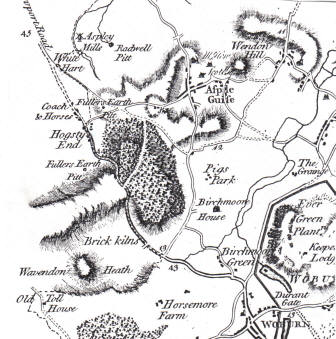
In an early local map of 1765, the Hogsty End part of Wavendon is clearly shown and it actually shows two local pubs, both of which have long since changed their names but are still open: The Coach and Horses now Swan and the White Hart now the Weathercock. Fullers Earth pits are shown near St. Vincents, off Weathercock Lane, as well as between Woburn Sands and Woburn where it was mined until the end of the 20th century. The area off Longslade Lane is shown as brick kilns and the windmill near to what is now Burrows Close is shown, which blew down in 1900. There are very few houses shown on the road through Woburn Sands.
The mapmaker has shown the steep hill between Woburn and Woburn Sands, which was infamous for bogging down horse-drawn carriages until the cutting was made through it. With no organised police force and most people being armed, this was a dangerous time to be running a public house on a main road. We will never know the type of clientele who frequented the old inns of Hogsty End at this time, but I can imagine them as being pretty rough-and-ready places.
According to the Ale House Register, in 1773, Francis changed the name of his inn to The Grey Hound. Perhaps they owned one, or there may have been a local champion dog who took part in races over Aspley Heath. The greyhound is also the symbol for the Duke of Newcastle and a type of mail coach, just the sort that would have been passing by regularly.
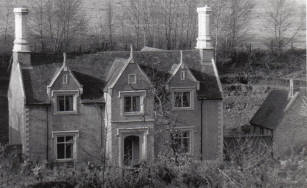
“Francis Moore came from Somerset and attended the Aspley Guise Classical Academy. Whilst still a pupil at the school he showed the right kind of aptitude to get on in life by marrying Susanna Sawell, daughter of the headmaster; this was in 1766*. In 1770 Sawell died and Moore, through his daughter, inherited a share of his estate. For the next fourteen years Moore conducted a feud with Richard How the younger of The Old House. This arose because Moore packed a vestry meeting and attempted to get Richard How the elder’s land assessed for payment of the parish poor rate (money collected for distribution amongst the poor on a pro rata basis from land and property owners in the parish) at an unfairly high level. The younger How accused Moore of falsely accusing his father of “ruling the parish” and that he: “insulted him grossly by Expression of Contempt, laughter, virulent invective, and the charge of fraud and dishonesty”. Moore was an aggressive young man who obviously thrived on discord and ambition. It is to him, however, that Aspley Guise and even more, Aspley Heath, owed their Victorian and Edwardian fame as health resorts. This was because Francis Moore bought up land on Wavendon Heath, in what was later to become Aspley Heath and, around 1778, planted 500 acres of it with 51,376 Scotch firs, for which he received a gold medal from the Society for the Encouragement of Art and Manufactures. Moore subsequently sold the 500 acres to the Duke of Bedford, in 1792, for £17,116, a truly vast sum for those days.”
[*He had actually married the Headmaster’s daughter in 1764 at St. George-in-the-East in London.] Moore later became a Colonel in the Bedfordshire Militia and an important part of the pub’s history. The trees on Aspley Heath have been harvested and replanted regularly ever since.
1779 to 1784 – Mary Lee
Francis Lee died in 1779 and was buried at Wavendon. His will reads:
“In the Name of God, Amen. I, Francis Lee of Hogsty End in the Parish of Wavendon in the county of Bucks, being weak of Body, but of sound and perfect Mind and Memory (thanks be to Almighty God for the same) do make and ordain in this my last Will and Testament in manner and form following,
And first, I give and bequeath unto my son, William Lee, All that my house and premises thereto belonging situate and being at Leighton Hollow in the parish of Wavendon.
And lastly all the rest residue and remainder of my personal estate, goods and chattels of all kinds and nature soever and whosoever I do give and bequeath unto my son, Edward Lee, whom I hereby nominate and appoint my whole and sole executor, provided he the said Edward Lee, doth take care that his mother Mary Lee do have a comfortable and reasonable a maintenance during her natural life…”
Edward must have decided the the best way to look after his mother and provide for her was to allow her to take on the inn and run it herself, so Mary took over the license.
James Asser’s map of Aspley Guise in 1782 shows a “House Stables and Co.” on the inn site, just beside an area called “Stubb’s Earth Pit“, while the present site of the modern pub on the corner of Aspley Hill and Woburn Road is noted as belonging to Mr. R. How. This was the Richard How of Aspley Guise described above, a member of an affluent merchant family who lived at The Old House. The family were Quakers and very much involved in the Friends Meeting House at Hogsty End, which has been operating since the 1650’s.
The Greyhound Inn stood beside an entrance to the woods, which led to a Fullers Earth pit and between the inn and Hogsty End proper was yet another pit. Fullers Earth has been dug locally since at least 1539, when King Henry VIII gave certain lands to one John Sheppard and notes that it was unknown how long previously it had been dug in the area. The substance was used historically to remove the grease from wool, allowing it to be spun easily. The local product was of a very high quality and there were cases of other inferior product often being sold disguised as the famous “Woburn Earth”.
Most mining was done by “bell mining”. A shaft was sunk down to where the layer of Fullers Earth was, then a man was lowered down to dig out what he could, in an ever increasing bell-shaped hole. The product was hauled up the shaft to the surface, until the hole created was in danger of collapse. Then another shaft was sunk beside it, the spoil used to back fill the first hole and shaft. It was a very dangerous method of work, which was last used in 1891, although there had been examples of open cast mining in use for many years by then. Many local men would have been involved in mining, refining or transporting the mineral and no doubt working up a quite a thirst in doing so.
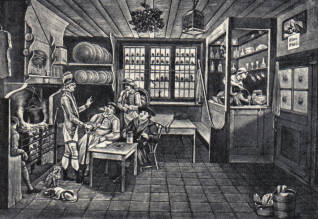
A Land Tax Assessment for 1781 shows Mrs. Lee was already the tenant of “Mr. More” [sic] and that £1 1s. was payable for the property, but I am not sure if it was the owner or tenant who was responsible. I have notes that the property and 35 acres of land running back to Leighton Hollow, (now Sandy Lane) was only sold in 1783 by Pithurst and Howard of Newport Pagnell, to Francis Moore of Aspley Guise, but I do not recall where the information came from. It is possible that Mary had mortgaged the property with the Newport firm. So the pub was already out of the hands of those running it and they had rent to pay. Mary Lee may have found it hard to keep the business going. No doubt she would have had help from the rest of the extended Lee family. Moore’s wife, Suzannah, died in November 1783. He remarried two years later to a widow, Sarah Reynel from Eggington, in Bedfordshire and moved there to live at her ancestral home, Eggington House.
1784 to 1788 – Martha Lee
There is a burial of a Mary Lee at Wavendon in 1784 and the Bucks. Alehouse Register begins to record a Martha Lee as the licensee from this year. I haven’t been able to prove the relationship between the two. Was it mother and daughter? Martha was certainly a name used by the local Lee family and Martha continues in the license book until 1788. For one year, 1786, an Edward Shouler is also recorded, but he was also noted as the licensee of the Leathern Bottel at Wavendon at that time too. Was it a simple typo?
In 1785, Miss M. Orlebar of Ecton, Northampton travelled though the area and recorded in her diary:
“We enter on Woburn Sands, passing some houses, called Hog Sty Houses and formerly very properly so term’d; but the spirit of improvement has even extended to them: and they are now become neat little Public Houses: the once barrin hills of sand are now covered with flourishing plantations of Fir Trees…”
I wonder if the Fir Tree was a “neat little Public House”? It would be nice to think so!
The next change of name occurred in 1786, when we reach the name we know now. The fir trees that Francis Moore had planted were now about 8 years old, so the old bare Heath was no more and a carpet of trees was springing up. The Lee family must have been prepared to move with the times and they renamed the inn to the Fir Tree.
Some of the local Wavendon Lee family had their eye on others way to make easier money. From the Oxford Journal, 13th October 1787:
“AYLESBURY GOAL, 9th October. THIS Morning, about One o’Clock, the following CONVICTS and PRISONERS committed for Tryal found Means for making their Escape, viz: WILLIAM LEE, under the same Sentence [transportation for Felony] upon the Deer Laws, Native of the Parish of Wavendon, near Newport Pagnell, Bucks; he is about five Feet high, of a black Complexion; has small black Eyes, and short strait black Hair, and was one the Gang of Deer Stealers with the above [William Reeve, William Hollis and Arthur Harris] when apprehended in Whaddon Chase…
As the Escape of the above Convicts and Offenders is of the upmost concern to the Publick, it is hoped that all Persons who may see this description of them, will use every means in their power that may tend to their discovery; and in order to promote such laudable endeavours, Notice is hereby given, that a Reward of TWENTY POUNDS is directed by Law to be paid to the Person or Persons who shall apprehend either of the above convicts. And as an Encouragement for the immediate Apprehending of the said HOLLAND, JOHN DAVIS and DAY, I hereby offer and promise to pay a Reward of five GUINEAS for each of them, to the Party or Parties who shall deliver him or them into my custody in the said Gaol. John Horwood, Gaoler. N.B. If any Person or Persons shall knowingly harbour or conceal any or either of the above Offenders, he, she, or they will be prosecuted to the utmost Rigour of the Law.”
William, his three accomplices in a deer poaching expedition and 10 other men had escaped. The others were mostly horse or sheep thieves, but one had been charged with murder of his wife. John Davis, a horse stealer, had the alias of “Rat”! I do not know if they were ever recaptured.
1788 to 1810 – William Morris
The Alehouse Register records another change of tenant in 1788, to William Morris. There is record of a marriage between a William Morris and a Martha Lee in Wavendon in September 1789, so no doubt Martha was still there but the license had transferred to her new husband. This corresponds perfectly with the first mention about the inn in a newspaper that I can find. On the 1st November, 1788, the Northampton Mercury ran this advert:
“Fir Plants & C. – All sorts of Scotch, spruce, Larch, Weymouth Pine, Silver and Balm of Gilead Fir Plants, from one to ten feet high. Also Ash, Chesnut, Laurel, Holly, and Crab sets, to be sold cheap. Enquire at the Fir Tree, Hogstye-End, near Woburn, Bedfordshire; or Mr. Richard Randall, Upper Bell, Aspley Guise, near Woburn aforesaid.”
It looks like Francis Moore’s trees were a booming business! So much so, he had to take out an advert in the Northampton Mercury of 28th March 1789, saying that as his woods “…have lately been frequented by Idle and Disorderly Person, and many YOUNG TREES Stolen, Cut & Destroyed and also the underwood… the Proprietor hereby offers a reward of FIVE GUINEAS to any one that will give Information, so that he Offender or Offenders may be convicted hereof…” Trespassers were warned that “All persons are desired to keep to the Foot-Paths, particularly in the night, as Spring Guns will frequently be placed in various parts of the Woods and Plantations.” I wonder where the Lee’s had been getting their plants..?
Moore insured all his premises in February 1789 and the entry in the Royal & Sun Alliance Insurance ledger survives at the London Metropolitan Archives [CLC/B/192/F/001/ MS11936/360/554283] His own house (now Moore Place Hotel in the centre of Aspley Guise) was covered for £700. As well as other properties in Aspley, Eggington and Bow Brickhill, the Fir Tree Inn at Hog Sty End, “...in the tenure of Lee…” was covered “…not to exceed £100…” and a brewhouse and stable near and a couple of cottages were covered for £20 each. It mentions that all were thatched and fire was the greatest risk at that time. He might have been just in time, as a bad fire broke out in Aspley Guise in 1792 at the house of a grocer and lacemaker, destroying several buildings before the Duke’s horse drawn fire engine could arrive and tackle the blaze.
Another advert appeared in November 1789, again in the Northampton Mercury:
“Fir-Plants and Forest-Trees. All sorts of SCOTCH, SPRUCE, WEYMOUTH PINE, SILVER, LARCH and BALM OF GILEAD FOR-PLANTS, from one to ten feet high, to be sold cheap. Also CRAB and THORN SETS, HOLLY, OAK, BEECH, ASH, BIRCH, Spanish and Common CHESTNUT &c &c. Direct or enquire of Mr. Richard Randall, Upper Bell, Aspley near Woburn, Bedfordshire, or Mr. Hughes, at the Fir-Tree, Hogstye-End, near Woburn aforesaid.”
Mr. Hughes’ relationship to Morris the then landlord is unknown. Maybe he was related, or perhaps he just rented some space there to sell trees from or it could have just been a convenient place to contact someone through, but the pub could have been growing the trees onsite.
There are two detailed maps of the area, showing the inn and outbuildings, both drawn in 1791 and now in the Russell Collection at Bedfordshire Archives (R1/221 & R1/290). The first shows the inn buildings clustered around an open yard, with gardens and yards surrounding them. The gardens are to the south of the inn, and would have been seen first if travelling from Woburn. I imagine these were of the cottage garden variety for vegetables rather than ornamental to attract passing travellers and coaches from the main road. The land slopes upwards quite quickly behind the inn and a measurement of 2 acres and 1 rood is shown for the inn and grounds.
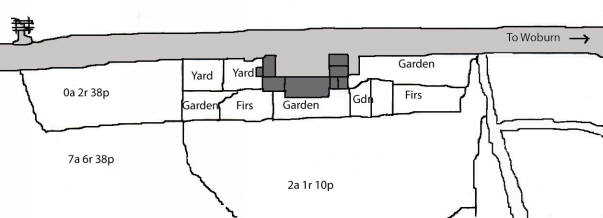
The other map of the same year, 1791, by J. Malcolm, shows the buildings at a slight angle to the road, with trees on both sides of it. It records “The Fir Tree Publick House, 44 miles from London”. Local milestones were very important to travellers, as these were the only signposts at that time and there were several locally. [N.B. I was unable to obtain permission to photograph maps in the Duke’s collection, so have made these copy sketches myself.]
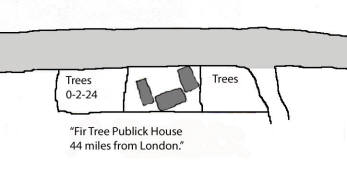 There is also a reference book (Beds. Archives R2/114) for a third map which gives a description of the Aspley Heath area. Alas, the map which showed where exactly the numbers referred to has not survived, but under the heading of “Aspley Wood”, the following appears:
There is also a reference book (Beds. Archives R2/114) for a third map which gives a description of the Aspley Heath area. Alas, the map which showed where exactly the numbers referred to has not survived, but under the heading of “Aspley Wood”, the following appears:
In this part of the wood the underwood is but thin, (particularly no. 20 and 21) some places are almost bare, it is much injured from the thickness and spreading tops of the trees. There are a few good stems to be found and probably would be many more were it not for the above mentioned cause. In no.22 and 23 the trees not being so thick as in 20 and 21 the underwood is tolerably thick and good. In all that part of the wood comprised in no.24 to 32 inclusive, the underwood is generally thick and good. It consists (as it does throughout the whole wood) mostly of oak, with some birch and a little hazel. There is a few spots that will be found to deviate from the above description, the principle cause of which seems to arrive from the extreme thickness of the trees in those places. The trees in this part of the wood (with the exception of that part under no.27 where only here and there one is to be found) stand in general very thick with spreading tops, and in those places where they are particularly so, are clearly very prejudicial to the underwood. As will be found to be the case oftentimes throughout the wood. Timber trees, oak, throughout the wood.”
Moore’s fir trees were still relatively young and it is interesting to imagine how the area looked in mature oak trees, so dense that the undergrowth had difficulty in surviving. The oak would have been seen as a profitable crop. I wonder if any of it went to the British naval ships of that period? Also in the same book, no. 30 on the schedule is identified as “Mermaid’s Pond”, still a local feature with a name much older than most would imagine.
The business of the Fir Tree selling Fir trees in 1788-9 had not been a one-off event. This from the 24th January, 1795, the Northampton Mercury ran this advert:
“To Planters – A large quantity of exceeding fine Scotch Firs, between two and three feet high, Spruce Firs – Weymouth Pines, in a very thriving state, may be had immediately, by applying to Mrs Morrice, at the Fir Tree, Hogstye End, Bucks; also Weymouth Pines, from eight to ten feet high, very fit for decorating a pleasure ground, as hiding any disagreeable object, may be had, by applying as above, on very reasonable terms.”
So Hughes had disappeared and the landlord’s wife taken on the nursery business. In the summer, they also sold turnip seed to supplement the income from the inn. Northampton Mercury 25th July:
“To Be Sold – A large quantity of Norfolk White and Green Turnip seed, of this years growth, wholesale and retail. Enquire of Wm. Morris, at the Fir Tree, Hogstye-End, near Woburn, Beds”
By now, the corner plot at Aspley Hill, where the modern pub stands, had transferred from Richard How to Francis Moore, so he now owned both the site of the original inn and where it would be based in the future. The next year, Francis Moore sold the site of the original inn to The Duke of Bedford. William Morris continues to be recorded as licensee until 1810, but before then, the name of Edward Lee, son of Francis, begins to appear in documents relating to the west side of the Woburn Road, where the inn stood. He is mentioned in both 1797 and 1798 in relation to paying for the upkeep of certain sections of the road. (Beds. Archives R4/608/23/1-2).
The Northampton Mercury announced in 1793 that the Hogstye End Statute Fair would be held. This occurred at a local inn each year, where farmers and estate managers could go to hire on staff. This seemed to alternate between the Coach & Horses (the Swan) and the Weathercock, but always ended with “…dinner on the table at one o’clock“.
As well as fire, wind could be a problem. A great storm occurred in 1795 which caused havoc with the woods. The Kentish Weekly Post reported in November:
“Considerable damage was done in the neighbourhood of Woodburn, [sic] Bedfordshire. A site of new building, erected by the Duke of Bedford, in his park, near the entrance from Wooburn, consisting of every building necessary for farming, two mills and workshops for every branch of building, all contiguous to each other, were nearly all razed to the ground. Upwards of 100 large trees in the park were blown down, and more than 300 fir trees, in Aspley wood and Longslade, were levelled, besides other considerable damage in the neighbourhood in general.”
The deep sandy soil roads just north of Woburn was still a problem to travellers in 1796, when his cartoon was made by Isaac Cruikshank the Elder (after George Moutard Woodward) of the passengers in their finery having to walk while the driver and guards trudge through the mud. “Stage coach Passengers passing Wooburn Sands” is the sarcastic title. It was published in the book, “Eccentric Excursions or, Literary & Pictorial Sketches of Countenance saying, Character & Country in different parts of England & South Wales” by George Moutard Woodward. The text accompanying the sketch mentions the “fell banditti” (evil bandits) that worked the area, but also gives a glowing description of a sunset over the woods and the beautiful autumnal colours.
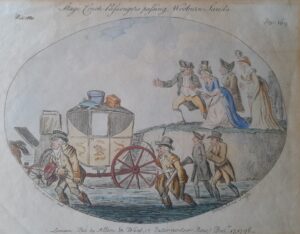
William Morris is listed as a Victualler in the Posse Comitatus of 1798, a list of men available to fight with the army and who were not Quakers, clergymen, or already serving in a military unit. This meant most males between the ages of 15 – 60 were listed. Also shown are four members of the Lee family as horse dealers and a William Lee as a victualler elsewhere in Wavendon. The Alehouse Register shows him as running the Plough public house from 1789 to 1822, when it was still in Cross End, before that pub name was used for a newer pub nearer to the Church. [All five Victuallers shown in the Posse Comitatus have the first name William!]
Whether celebrations at the end of the 1700s matched those we had in 1999 I do not know, but the pub continued into a new century. The Lee and Morris families were certainly still tied quite closely together, as this advert from the 1st September, 1804, Northants Mercury shows:
“Stolen or Strayed – Late on Sunday Night the 26th, or early on Monday morning, the 27th August, 1804, from a close belonging to William Morris, Hogstye-End, near Woburn, Beds., a bright-bay mare, of the nag kind; aged, about fourteen hands and half an inch, has a star in her face, and two knobs on her back, done with saddle. Whoever will bring her to the Fir Tree, Hogstye-End; or to Edward Lee, horse dealer, Leighton Hollow; will be handsomely rewarded, and all expenses paid, by Edward Lee.”
1810 to 1823 – Edward Lee
Just across from the old Fir Tree site is another entrance into the woods. Here, the Henry VII Lodge was built in 1810-1811. Of course, this is not during the reign of Henry VII, but the name referred to the Gothic styling of building. I’m sure the locals gaped in wonder at this building when it was new – it still attracts attention now. It originally had two neat little hedge mazes, visited by Queen Victoria in 1841, but they fell into decline and have been cleared away. They stood just to the north of the cottage (A full description of that house and gardens can be found elsewhere on this website.)
Early 1810 saw the death of (by then) Col. Francis Moore in his 63rd year. Although he had moved to Eggington, his son John Patrick Moore stayed very much connected to Aspley Guise and a grandson, John Vaux Moore, later become vicar there. Several large sales were held to dispose of his widely dispersed estate. At Bow Brickhill, 130,000 bricks and brick-making tools were sold from the brickyard he owned there. At Aspley, his furniture was brought back from Eggington for sale and included seasoned Goose-featherbeds, mahogany card tables and Turkish carpets as well as carriages, ploughs and 30 sheep. He was buried by the north wall of St. Botolph’s in Aspley Guise in a large flat-topped tomb.
Also in 1810, the Morris name ceases as the licensee of the Fir Tree in the Alehouse Register and the title reverts to the Lee family proper, with Edward Lee, son of the Francis who ran it before. He was 63 at this time, quite an advanced age for the time to take over an inn. There is another Bedford Estate map of 1819 (Beds. Archives R1/226) by Thomas Evans, which shows the inn as called “The Yew Tree”. This name only appears on this and two other maps (one by James Asser in 1820). The late local historian Parker was convinced it was a simple mistake, as the Ale House Register records no change of the name around this time. I doubt that the inn would have taken a new name of a tree which was not prevalent in the district then reverted to its old name, so I am inclined to agree with him. The other map it appears on is a later extract made from the original Toll Road map c.1810, entitled “Plan of Part of the Northampton Road between Newport Pagnell and Woburn“, with the same erroneous “Yew Tree”. (Beds. Archives HN1/34)
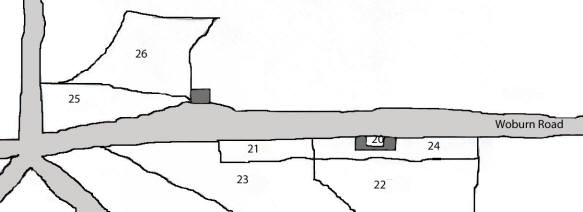
The numbers on the 1819 map are for an accompanying reference book, which details:
Land in the occupation of Edward Lee, tenant:
20 Public house, yard and garden
21 Piece formerly a plantation
22 Home Close 2a. 1r. 10p. arable
23 Long Close
Land belonging to the Duke of Bedford:
25 Piece of ground part planted and part water with a newly erected Lodge [Henry VII Lodge] – Gabriel Ireland
26 Aspley Close 3a. 0r. 24p
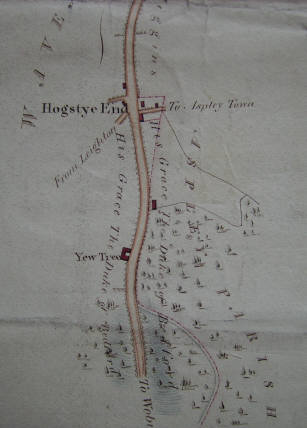
Three of the local Lee’s had to promise to pay for the upkeep of Ann Percival’s child after she swore that it was Thomas Lee who had made her pregnant in 1814. “Thomas Lee of Leighton Hollow in the parish of Wavendon in the county of Buckingham, labourer, Edward Lee and Francis Lee both of the Fir Tree Public House in the parish of Wavendon aforesaid are held and firmly bound to John Battams and Thomas Odams, Churchwardens and George King, overseer of the Poor of the Parish of Wavendon”. If a mother and child had no working man to look after them, the parish had to step in to pay, which meant local rates had to be paid. The Lee’s had been bound by a penalty of £50 if they did not pay “…the sum of two pounds for and towards the lying in of the said Ann Percival and the expenses attending the same. And also pay or cause to be paid to the said Churchwarden and Overseer of the poor of the said Parish of Wavendon… the sum of Two Shillings weekly and every week to commence at and from one month after the birth of the said Bastard child for and towards the keeping sustentation and maintenance of the said bastard for and during so long time as the said bastard child shall be chargeable to the said parish of Wavendon then this obligation to be void or else remain in full force and virtue.” Back in 1759, Edward had had to get his own father to stand surety for him, when he’d done the same thing! (Like father, like son…?)
Edward Lee and his wife Mary had three sons and enjoyed 13 years of running the Fir Tree Inn before his death in 1823, aged 76. His will had been written in February 1818 and tells us he was the owner of three cottages in Leighton Hollow and some land at Longslade.
“In the name of God, Amen. I, Edward Lee of Hogstyend in the Parish of Wavendon in the County of Bucks, Victualler, being weak in body but of sound mind and disposing mind and memory and understanding but considering the uncertainty of this mortal life do make and ordain this my last Will and testament in manner following.
First and principally, I commend my soul to almighty God and my body I desire may be decently interred at the discretion of my Executor or Executors herein after named.
As to such worldly estate as God in his goodness as bestowed on me, I give and dispose thereof as follows:
That is to say, First I give and devise to my son Wm. Lee of Leighton Hollow in the said Parish, that messuage or tenement wherein he now dwells and the gardens adjoining the same and one half of the new stable that end adjoining to the house.
Second, I give and devise unto my second son Thomas Lee of the same place that messuage or tenement wherein he now dwells and the garden adjoining the same and the other half of the new stable.
Likewise I give to my son Francis Lee of Hogstyend that other messuage or tenement called the Old House and the sand pit garden. Likewise, the orchard and the old workshop to the said Francis Lee. Likewise I give all my personal, horses carts & co to my two sons Wm. and Thomas Lee, being at Leighton Hollow only. Likewise I give unto my son Francis Lee the possession of my house and trade as victualler with all my effects in the said house and premises. Item, my will is that my piece of sward ground lying and being at Long Slade in the said parish of Wavendon, be sold by auction within six months after my decease and the remainder of the money when all just dues and debts are all paid the remainder of the money to be equally divided amongst them.
And lastly I do hereby nominate and appoint John Piddington of Woburn, Beds, my sole executor of this my last will and testament hereby revoking and making void all other wills and testaments by me at anytime hereto for made and do declare this to be my last will and testament. In witness whereas I, the said Edward Lee the testator, have this day made this my last will and testament contained on two sheets of paper to the first sheet whereas I have set my hand by mark, and to the second and last my mark and seal, this fourth day of February in the year of our lord one thousand eight hundred and eighteen.
The mark of Edw. Lee x
Signed sealed and published and declared by the said testator Edward Lee as for his last Will and testament in the presence of us who at his request in his presence and in the presence of each other have subscribed our names as Witnesses thereto. Witness Wm. Adams, Cha. Griffith, Robt. Inwood. Administration with the will annexed granted to William Lee and Francis Lee Feb 14th 1825 in the Archdeanery of Bucks.”
1823 to 1852 – Francis Lee
On Edward’s death, William and Thomas, his younger sons, inherited a cottage each and shared his farming stock, but it was his eldest son, Francis, probably named after his grandfather, who received the tenancy of the inn.
William eventually sold his lands to the Duke of Bedford in 1826. Thomas had married in 1815 to Sarah Impey and died in Wavendon in 1850. On his death, with no children of his own, his lands passed to his nephew, Francis’ son, Thomas.
Much of the local Fullers Earth mining was centred on Aspley Heath, which is where the above mentioned Leighton Hollow was situated. If you walk up Sandy Lane to where the footpath from Holly Walk meets it, there is a small area of open ground on your left, where the trees have been cleared away, just passed the big sandpit. This was the site of Leighton Hollow, also known as George’s Square. Sandy Lane was at one time the main route out westwards from Woburn Sands. Before the Bow Brickhill Road was threaded through the fields, this was the way over to the Brickhill’s and beyond.
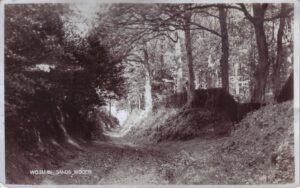
A small collection of squatters’ cottages grew up here and were tolerated by the parish landowners, until like the rest of Aspley Heath, they became settled. There were very basic houses, with a well in the centre of the houses and the Lee family were involved in besom (brush) making, collecting the material they needed from the woods.
Much later, the well was used to supply some of the early convalescent homes that were built on Aspley Heath. The water was piped across the Heath in lead pipes; not very healthy! The late Solomon Leadbeater told me that one of his first jobs as an apprentice builder was to be sent down the well to cut off the lead pipe as low as possible to salvage the metal when the site was cleared. He was lowered down inside the well, which was dry, as far as they could, then he began to cut through the pipe. However, the saw got stuck and when he conveyed this information to his colleagues up above, they dropped a hammer down to help him. Luckily, it landed in the tiny bit of space at the bottom of the well his body wasn’t in!
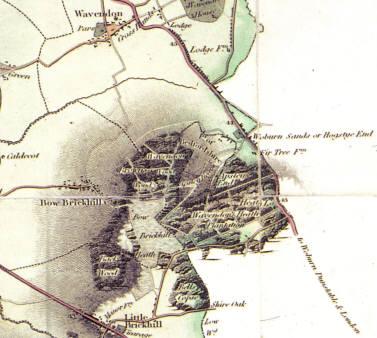
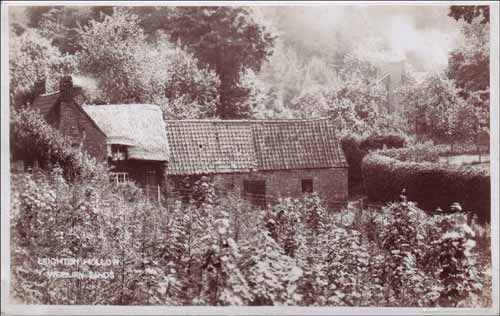
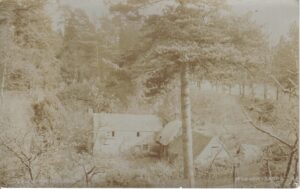
It would seem that this second Francis Lee was baptised on 10th October 1784, but according to the 1851 census, he said he was born in 1770 and was described as victualler and farmer.
In 1811, at the age of about 41, he married Mary Sharpe of Aspley Guise. She was 19 and they produced seven children:
Ann, born 1813, died a spinster in 1890. Buried at St. Michael’s, Aspley Heath.
Sarah, born c.1815?, died 1841.
Francis, born 21st May 1820.
Thomas, born 1822. A railway worker at Bow, he died in December 1865, crushed between the buffers of two railway trucks.
Elizabeth, born 1825, died 1841.
Mary, born 1828, died 1838.
Martha, born 1830, died 1844.
In 1826, the Lee family bought and mortgaged some land on Longslade Lane. Francis, Edward and William Lee all signed the deeds but only Francis could write, the others just made their X mark.

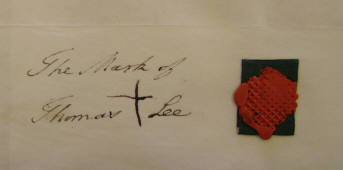
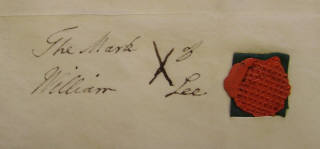
In an 1827 inventory for the Ampthill brewery of John and Joseph Morris, now at Bedford Archives (Z1043/1), a Francis Lea of Hogsty End is listed as owing the brewery £16 2s. 9d. They considered the debt ‘Doubtful’. I would have thought that Lee would have brewed his own beer on site, but perhaps demand had outstripped supply. Also this year, the Bucks Licensed Victuallers report shows that a William Lattimer of Hanslope was standing surety for Lee. Lattimer ran the Watts Arms and Lee returned the favour by standing surety for him. Forty years later, the practice of standing surety for another landlord would lead to a great deal of trouble for the Lee’s…
Although identified on a map in 1819 as belonging to the Duke of Bedford, the site of the modern pub had been sold by the son of Francis Moore (who died 1810) in 1829 to one James Young, identified in the conveyance as the local brickmaker. He paid £120. Moore son could not produce any deeds to the site, but believed the site had been a gift from his father. Young was already in occupation of the site, using it as a brickyard. It was described as “…three cottages, brewhouse, woodbarn, stable, hovel and other outbuildings…” which had been erected by Young. The site was much larger than today, having a frontage of 56 yards to the Woburn Road, 48 yards to Aspley Hill, and 44 yards on both other sides. James Young died in 1839 so his property was split between his widow and their two sons, James and Henry. James Young junior inherited the Aspley Hill corner plot and buildings.
None of the Lee’s appear on a list of those eligible from Wavendon to serve with the Militia in 1831, but a John Young does. Francis may have been just too old at 45 and his children too young.
Before the last of Francis Lee’s children was born, there was a major event in the Fir Tree history. Francis is listed in the 1840 Tithe Apportionment as then occupying an inn on the site on the corner of Aspley Hill and Woburn Road. Local historian Arthur Parker believed the transfer from the Woburn Road site to this corner must have been made sometime in the late 1830’s and thought it was possibly a fire which led to the move. Old timber thatched buildings were often destroyed this way but perhaps Francis wanted a more central location for his business, at the junction of two main roads. With the coming of the railways and canals, perhaps there were fewer carriage customers to stop at the little inn on the roadside now. The building on the old site is not included on the Tithe, so it must have been destroyed, by accident or design, before 1840. The slightly gothic-looking Fir Tree Cottage was later built on that site and still remains there today.
The Tithe Apportionment also shows that Young’s were still the owner of the site, so Francis Lee was their tenant. Perhaps the Lee’s had had an offer from the Duke of Bedford for their old plot and used the capital to start the new inn. Maybe it was the facility of the brewhouse which appealed to Francis and he could have started afresh, however, when the transfer was made from the old inn to the new, they decided to take their inn name with them. So finally we are looking at the same named pub being on the same site as it is today, but this was in an earlier building.
This auction notice from the Northampton Mercury, 1st August 1840, lists Francis as having 8 1/2 years left of his tenancy. Perhaps it had been a 10 year lease, meaning they had moved in mid-1838. Having just inherited the buildings, the Young’s had tried to sell them. The advert gives us a good description of the new public house:
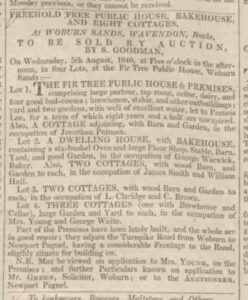
“Freehold Free Public House, Bakehouse, and eight cottages at Woburn Sands, Wavendon, Bucks to be sold by auction by S. Goodman. On Wednesday, 5th August 1840 at Five o’clock in the afternoon in four lots, at the Fir Tree Public House, Woburn Sands:-
Lot 1. The Fir Tree Public House & Premises, comprising large parlour, tap room, cellar, dairy, and four good bed-rooms; brewhouse, stable, and other outbuildings, yard and two gardens, with well of excellent water, let to Francis Lee, for a term of which eight years and a half years are unexpired; also a Cottage adjoining, with barn and garden, in the occupation of Jonathan Puttnam.
Lot 2. A dwelling house, with bakehouse, containing a six bushel oven and large flour shop, stable, barn, yard, and a good garden, in the occupation of George Warwick, baker.. Also two cottages, with wood barn, and garden to each, in the occupation of James Smith and William Hall.
Lot 3. Two cottages, with wood barn and garden, to each, in the occupation of L. Claridge and C. Brown.
Lot 4. Three cottages (one with brewhouse and cellar) large garden and yard to each, in the occupation of Mrs Young and George White.
Part of the premises have been lately built, and the whole are in good repairs, they adjoin the Turnpike road from Woburn to Newport Pagnel, having a considerable Frontage to the road, eligibly situate for building on.
N.B. May be viewed on application to Mrs Young, on the Premises; and further Particulars known on application to Mr Green, Solicitor, Woburn, or to the Auctioneer, Newport Pagnel.”
…but it did not sell, as the Young’s remained the owners.
The first proper Census took place in 1841 and although few specific addresses are given, we can find Francis Lee listed under Hogsty End, Wavendon as a “Publican” of 55 years of age, with his wife Mary (46) and their six children; Ann (25), Sarah (24), Francis (20), Thomas (18), Elizabeth (16) and Martha (10). This year also saw a visit by Queen Victoria to see the hedge-mazes at the Henry VII Lodge. If Francis had still have had the old inn, he would have had a prime view!
The railway arrived in Woburn Sands in 1846 and the new station meant prosperity for the local tradesfolk who could now export locally made goods easier and also brought a surge of visitors who needed services. It was part of the Bedford to Bletchley line, backed by the Duke of Bedford himself, which was later extended through to Oxford and Cambridge. The Duke had wanted a station at Woburn, but the engineers said Wavendon Heath was too hilly to lay track across. It was an excellent time to have a new inn at the centre of the village where the roads crossed. “Francis Lee, Fir Tree Inn” appears in the first Kellys Directory for Buckinghamshire in 1847, the forerunner of the telephone book, where all private residents and trades people were listed. Although listed under Wavendon, the publishers had already separated “Hogsty End or Woburn Sands” into a sub-section of Wavendon parish – a foretaste of how the area was developing fast and leaving Wavendon behind.
Just to cement their position, Francis’ oldest son, yet another Francis, now 28, got married to Eliza Peters Young on 3rd July 1848 at Wavendon. This was the daughter of James Young jnr. So the tenant publican’s son had married the site owner’s daughter and a new chapter of the Fir Tree history began.
Page last updated Mar. 2023.
